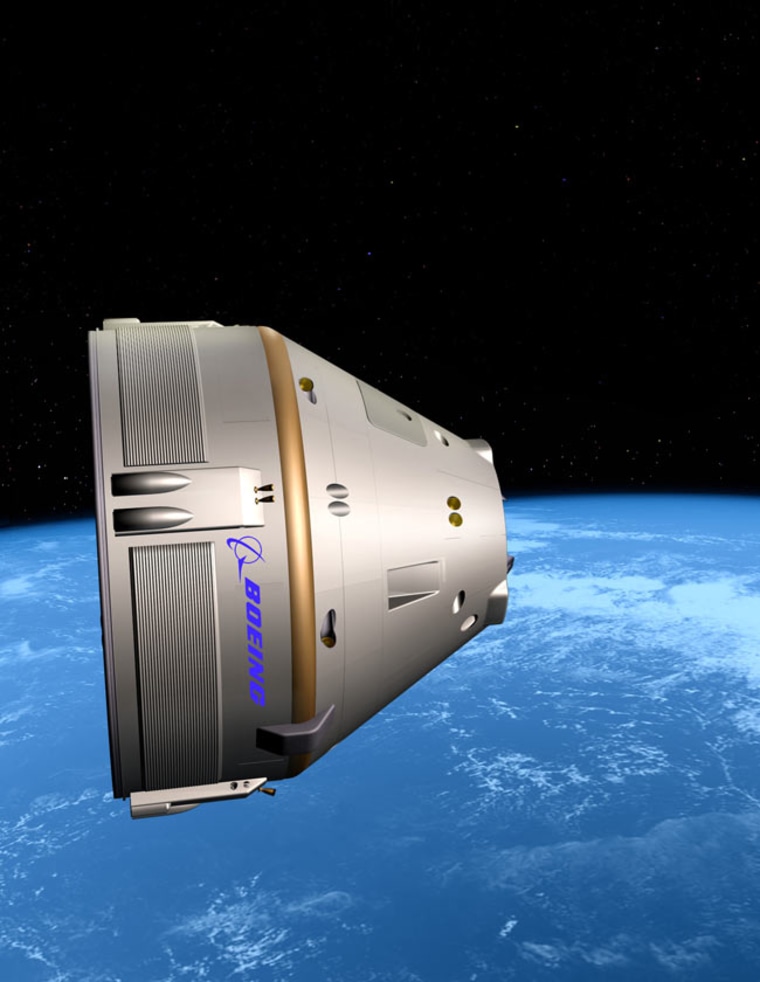Aerospace heavyweight Boeing is advancing plans for its new capsule-based spaceship, designed to ferry people to and from the International Space Station and future private space stations. The capsule design is part of an effort to fill the void that will be left by the 2011 retirement of NASA's space shuttle fleet.
The new Crew Space Transportation-100 spacecraft (CST-100) is part of the company's $18 million award from NASA under the Commercial Crew Development Space Act Agreement. The award aims to advance the concepts and technology required to build a commercial crew space transportation system.
Boeing's capsule design is one of several efforts by different U.S. companies to develop the first private spaceship capable of flying humans to space. The push fits in with President Barack Obama's new plan for NASA, which calls for commercial spacecraft to take over the role vacated by the space shuttles of transporting astronauts to the space station.
Taking cues from the past
New artist's renderings of Boeing's CST-100 capsule were unveiled July 19 in a media briefing at the Farnborough International Airshow in Farnborough, England. (Video: Boeing's New Spacecraft)
Boeing's new spaceship design will look similar to NASA's cone-shaped Apollo and Orion spacecraft.
The Apollo capsules were built to fly astronauts from Earth to the moon in the late 1960s and 1970s. The larger Orion vehicles were part of NASA's Constellation program to return astronauts to the moon, which was cancelled by President Obama as part of his new proposal. The Obama administration did resurrect Orion, though, to serve as a space station lifeboat.
The CST-100, which can carry up to seven people, will be bigger than the Apollo spacecraft but smaller than the Orion capsule. It is designed for short missions to space, and the "100" in the name stands for 100 kilometers (62 miles), the distance from the ground to low-Earth orbit that it will travel.
Boeing plans to launch the CST-100 capsule from Florida, but has yet to determine which rocket will carry it into space. The spacecraft is being designed for compatibility with a variety of different rockets, including United Launch Alliance's Atlas and Delta boosters, and SpaceX's Falcon rockets.
Multiple customers
While NASA could be the main user of the CST-100 capsule, the space agency is certainly not the only customer that Boeing has in mind. The company has teamed up with Bigelow Aerospace, a Las Vegas-based company that joined the Commercial Spaceflight Federation in June.
Boeing hopes to use the CST-100 capsule to take people to and from the Bigelow Aerospace Orbital Space Complex a commercial space station the company is building.
Bigelow Aerospace is developing private inflatable space habitats with the goal of launching the first private space station in 2014. The company has already launched two prototype modules into space.
For the new CST-100 spacecraft, Bigelow Aerospace will assist with demonstrations and design work in areas where they have cultivated experience from the design and construction of their orbital facilities and commercial space complex, according to officials at Boeing.
The partnership between Boeing and Bigelow Aerospace also represents an important stepping stone toward creating a robust commercial spaceflight industry, the companies said.
